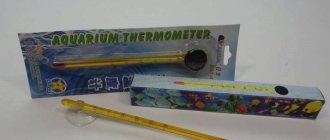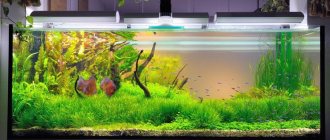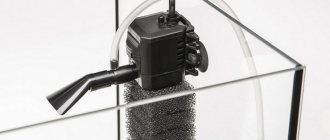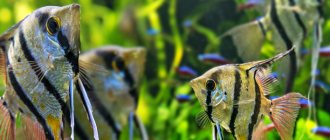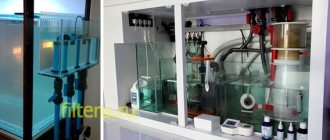Primary water treatment unit.
The main sources of water supply for RAS can be deep wells, wells, local water supply, nearby rivers or lakes. Quite often the water in them does not meet regulatory fish farming requirements. A very large number of underground water sources in Belarus contain iron and heavy metals in doses exceeding the MPC. Often these sources also contain nitrogen ions. In this regard, such water must be treated before being supplied to the RAS, removing from it all substances harmful to fish. For these services, you must contact specialists involved in primary water treatment. Based on an assessment of water analyzes from a particular water source, they can recommend appropriate equipment, identifying its individual strengths and weaknesses.
Photo 1: Primary water treatment unit.
Swimming pools
In shape they are round, rectangular, longitudinal, oval or longitudinal with rounded corners. The most technologically advanced are round pools. The ratio of the diameter to the height of the pool should be 3:1 (N. Barulin, 2016). In such pools, the circular movement of water creates a uniform flow throughout the entire depth, allows the entire volume of water to be enriched with oxygen and does not have stagnant anaerobic zones, and the concentration of suspended matter occurs in the center, at the bottom of the tank. It is advisable to make the bottom of a pool intended for growing trout or African catfish cone-shaped, while for sturgeon or eel it is better to be flat, with the possibility of supplying water for cleaning both through the top and bottom of the pool. They are often equipped with a double drain: one for supplying recycled water for treatment, the other for removing sludge outside the RAS. The disadvantage of round pools is the irrational use of the total area of the RAS, which cannot be said about square and rectangular pools.
Scheme 1: Design options for pools for RAS.
Mechanical filters
They are structurally of the MSBF type (mechanical mesh drum filter), disk, with functions similar to MSBF, and also in the form of tubular or plate settling tanks. Very often, RAS purify water from suspended matter using submersible filters with a fixed plastic load. The advantage of MSBF and disk filters is that manual labor is required for maintenance; they are quite reliable in RAS with a high hydraulic load. The degree of purification of solids in MSBP: with cells of 30 microns (μ) - 99%, 60 μ - 48% and 100 μ -21% (M. Hochleithner, 2010). Disadvantages - high consumption of rinsing water: the smaller the mesh cells, the greater the water consumption with partial blockage of the cells, electricity consumption, higher price compared to other devices. However, MSBFs are very widely used in modern RAS. The advantages of settling tanks and submersible filters are a high degree of water purification from suspended matter, 90 - 95% (Dr. F. Ruemmler, 2010) with the sedimentation of very fine particles, and, what is very important, partial nitrification and diffuse denitrification. These filters are used in all trout RAS in Belarus. Their disadvantage is manual labor when regenerating the load and draining contaminants.
Scheme 2: Installation of MSBF in RAS
Biofilters
Filters for biological purification of RAS water are also called bioreactors. Depending on their purpose, most of them are drip (trickling) or irrigated, submersible with a fixed loading and with a moving bed (MBBR - moving bed bioreactor) (MB Timmons and JM Ebeling, 2010). Trickling filters are a kind of tower, 1-5 m high, with large plastic bioblocks stacked on top of each other or a lattice frame filled with small biological media with an active surface of 200-400 m2/m3. The water sprayed from above flows down in a thin layer through the bioload, enriching itself with oxygen, oxidizing ammonium and freeing itself from carbon dioxide. The average specific productivity of such a biofilter is 0.52 g NH4-N/m2/day (Knoesche, 2009). Its advantage is that these processes occur simultaneously in the filter. Disadvantages - it requires a room with a high ceiling, high energy costs for supplying water to a given height and blowing air. Submersible biofilters (water tanks) are filled with biological products with an active surface of up to 800 m2/m3 or more. The ratio of the volumes of biological products and water is 50%: 50%. These filters come with downward or upward flow of water, with compressed air supplied from below from diffusers to enrich the water with oxygen. The average specific productivity of such a biofilter is 0.36 g NH4-N/m2/day (Ruemmler u. Knoesche, 2009). The advantage is the ability of this biofilter, along with nitrification, to provide diffuse denitrification due to the anaerobic zones partially formed in it. The disadvantage is that these filters require periodic washing and sludge discharge. MBBR is a biological filter in which the load is in constant motion through a flow of air or water. Due to this, thick layers of biofilm are periodically washed off from biofillers, allowing the most productive thin layers of biofilm to more efficiently carry out the process of oxidizing ammonium to nitrates. The advantage of MBBRs is their high productivity - up to 1.3 g NH4-N/m2/day (Ruesten ua 2007), no need for regeneration of the charge, large biomedia capacity - up to 70% of the total tank volume. In modern RAS they are almost always present. The disadvantage is the lack of a diffuse denitrification process, energy consumption for water movement and air supply.
Features of the use of the above biofilters in combination with mechanical filters and depending on the types of aquatic organisms are noted in the table below.
Table 1. Options for combination of mechanical filters and MBBR in RAS
Biofilm formation
Its formation includes three stages: absorption of molecules necessary for bacterial contact, colonization of the substrate by a pioneer group of bacteria, reproduction and secondary attachment (Characklis, 1981; Costerton, 1999). In fact, phytoplankton bacterial cells reversibly attach to the substrate after treating its surface with organic molecules and minerals. At this stage, inhibition of synthesis and subsequent loss of flagella are observed, which disrupt the structure of the biofilm. The production of exopolysaccharides, which play an important protective role (increase resistance to antibiotics, disinfectants and detergents) and mechanical role (attachment to the substrate) (Watnik and Kolter, 2000; Michaud, 2007), is steadily increasing. After this, cell division occurs, the volume of biomass increases and the formation of a mature biofilm with effective extracellular communications occurs. Finally, part of this film peels off and free planktonic bacteria are released, which take up new free substrate (Costerton, 1999; Ghigo, 2006).
The picture shows the stage of bacterial biofilm formation
Adders
Adder pools are usually present in large classic RAS. They concentrate water that has undergone biological treatment in order to connect disinfection systems (UV or ozone sterilizer) to the RAS bypass, heating, pH stabilization, fresh water replenishment and pumping of additionally treated water for its subsequent supply to degassing and oxygenation units, and from them to fish ponds. The disadvantage of adders is the need for additional space for their installation. In small RAS, instead of adders, small pump pits with similar functions are used.
Scheme 3. Pool-adder.
Biological filtration
Biological filter
One of the key links in the recirculation system is the biological filter. It typically consists of a cylindrical reactor containing a filler material designed to increase the contact surface and promote bacterial growth (Avnimelech, 2006; Gutierrez-Wing and Malone, 2006).
Regardless of the type of system (marine or freshwater, small aquarium or large farm), the biofilter carries out aerobic and anaerobic processes to remove contaminants in the form of ammonium and carbon dioxide. Ammonium is produced by fish, and carbon dioxide is produced from uneaten food and feces (Schreier et al., 2010).
Traditionally, a biofilter characterizes the volume of substrate (m3) included in it, or the ratio of the surface area of the substrate to its volume (m2/m3) (Drennan et al., 2005). Today, the filler market is very diverse and includes sand, shells, expanded clay, and plastic material.
The selection of a suitable biofilter affects the investment and operating costs of the RAS, water quality and water treatment efficiency.
Denitrifiers
This is a unit designed to convert nitrates accumulated in circulating water into nitrogen gas, N2. Its advantage is that having a denitrifier in the RAS eliminates the need for additional use of water to maintain the level of nitrates in the RAS water at the optimum. Disadvantage: constant care is required, adding methanol or other substances to the water to maintain anaerobic heterotrophic bacteria at the proper level. In RAS, where diffuse denitrification takes place, this unit is not used.
CO2 blow off unit
In the water of an operating RAS, carbon dioxide is released as a result of the respiration of hydrobionts and the nitrification process. For every gram of oxygen consumed by fish, 1.2-1.4 g of carbon dioxide is released. This gas is very soluble in water and at high concentrations (more than 20 mg/l) further prevents the flow of oxygen to fish through the gills (Schlottfeld, 1980). To prevent CO2 from accumulating in the water, it must be blown off with air, based on the supply of 80-120 m3 of air to the water for every kilogram of food consumed by the fish. In practice, for these purposes, an “aeration/degassing field” is constructed in the form of separate pools with a centralized supply through compressed air diffusers. The disadvantage of this method is that it requires additional space, a separate pool, and energy costs. This problem can be solved cheaper by using an airlift system in each RAS. They simultaneously saturate the water with oxygen from the air. Airlifts performed very well at the sturgeon RAS of the Vasilek farm in Belarus.
Photo 2. Airlift in RAS FH Vasilek
Biofilm composition
Typically, the structure of a bacterial biofilm consists of a complex of cellular aggregates immersed in a protective self-reproducing matrix. This matrix, constructed of extracellular polymeric compounds, inhibits the attachment of other organisms and thus plays an important role in competition for resources (Davey and O'Toole, 2000; HallStoodley et al., 2004). In addition, partial heterogeneity affects the behavior and overall functionality of the biofilm (Xavier et al., 2004).
Oxygenation
This is a method of enriching water with technical oxygen.
In fish farming there are two methods of oxygenation: pressure and non-pressure. In the pressure chamber, oxygenators are used - units that provide forced dissolution of oxygen. Oxygen can be supplied there from cylinders, gas tanks or oxygen generators. The distribution of O2-enriched water among the pools is carried out by a pump. When using a pump with a pressure of 1.3 bar, water saturation with oxygen is ensured up to 300-400%. This method is used when keeping fish with high stocking densities. There are also low-pressure oxygenators (0.1-0.2 bar) that operate afloat directly in fish pools. The disadvantage of this method is the cost of purchasing oxygen and the consumption of electricity by pumps and compressors. In the non-pressure method, oxygenators are used, in which a flow of water through nozzles is sprayed over a layer of oxygen, mixed with it and fed by gravity into the pools. In this case, the saturation of water with O2 is no more than 200%, but additional electricity consumption is no longer required.
Scheme 4. Oxygenator circuits
Nitrification occurs in two stages
At the first stage, ammonium-oxidizing bacteria convert ammonium into nitrite. These bacteria include two phylogenetic groups:
1. In marine systems. The genus Nitrococcus, which belongs to the β subclass of Proteobacteria and is represented by two marine species (Koops and Pommerening-Röser, 2001); 2. In freshwater systems. Gamma subclass of Proteobacteria, represented by the clades Nitrosospira and Nitrosomonas (Michaud, 2007).
Ammonium oxidation has the following form: NH4+ + 3/2 O2 → NO2— + 2H+ + H2O + 84 kcal mol-1
First, ammonium is oxidized to hydroxylamine as an intermediate product, and then to nitrite. The process involves two enzymes: ammonium monoxide genase (AMO) and hydroxylamine oxide reductase (HAO) (Tsang and Sukuki, 1982; Bock et al., 1991). Hydroxylamine is the first product of aerobic oxidation. Under anaerobic conditions, nitrite formation from hydroxylamine is reduced (van de Graaf et al., 1996).
In the second stage, nitrite is oxidized to nitrate by various groups of microorganisms, nitrite-oxidizing bacteria (NOB). These bacteria include four groups (Egli, 2003).
The main group belonging to the α subclass of Proteobacteria has only one genus Nitrobacter, which is divided into four species, two of which are marine (N. mobilis and N. gracilis, belong to the β and γ subclasses of Proteobacteria, Koops and Pommerening-Röser, 2001). Another genus, Nitrospira, includes two species, N. marina and N. mascoviensis (Ehrich et al., 1995), which are part of a phylum belonging to the δ subclass of Proteobacteria (Michaud, 2007).
The oxidation reaction of nitrite to nitrate has the following form: NO2— + 1/2 O2 → NO3— + 17.8 kcal mol-1
Several enzymes are involved in this process: nitrite oxide reductase (NOR), cytochrome a1 and a2, quinine and NADH dehydrogenase (Bock et al., 1986; Bock et al., 1990).
If the mechanisms of nitrification have already been comprehensively studied (van Rijn, 1996; Aoi et al., 2000; Koops and Pommerening-Röser, 2001; Egli, 2003; Tal et al., 2003; Sharrer et al., 2005; Michaud, 2007), The study of the flora of heterotrophic bacteria began relatively recently (Michaud et al., 2006, 2009). These bacteria play an important role in oxygen consumption, the formation of metabolic by-products after cell lysis, and the outbreak of fish infections. In addition, they compete with autotrophic bacteria for oxygen and substrate, and significantly inhibit nitrification (Zhu and Chen, 2001a; Léonard et al., 2002; Michaud et al., 2006). In fact, in a biofilter, heterotrophic bacteria develop faster and predominate on the outer layer of the media, directly consuming oxygen from the water. This has a detrimental effect on autotrophs, which grow more slowly and in deep layers of litter (Lewandowski et al., 1993; Zhu and Chen, 2002). Competition is critical to filter efficiency and ammonium oxidation. It is especially relevant when the availability of organic carbon for heterotrophic bacteria is high (Zhu and Chen, 2001b; Michaud et al., 2006).
Aeration
Saturation of RAS water with oxygen from the surrounding air is the simplest and least expensive method compared to oxygenation. As already indicated, this can be done by installing airlifts (air pumps) in each pool. Depending on the water temperature, organic concentration and atmospheric pressure, an O2 concentration of 5 to 12 mg/l can be created using an airlift. Thus, in one cube of water there will be 5-12 thousand mg of oxygen. With water exchange 1 time per hour, about 30 kg of sturgeon can be grown in it, and with 2 times - already 60 kg, weighed up to 2 kg/piece. You can also saturate water with oxygen from the air by installing one aeration column in the RAS. Its advantage is the centralized aeration of all circulating water. Aeration columns have been successfully operated for many years in the acne recirculation system of the Aktam Fish farm in the Miory district of the Vitebsk region.
Photo 3. Airlifts and aerators in Miory.
This article discusses only some operating principles, strengths and weaknesses of the main RAS equipment. By combining one unit with another in a RAS chain, one can achieve high efficiency in fish farming. However, without complete knowledge in this area, it is impossible to achieve sustainable production. It is recommended to contact appropriate specialists.
Pavel Aksimentyev
RAS developer
Bacterial cleaning
In water recirculating systems, bacteria can be classified into one of two main groups: 1. Almost all organic matter consists of carbohydrates, amino acids, proteins and lipids. They come with uneaten food, dead carcasses and fish excrement, and are mineralized by heterotrophic bacteria, both in the filter and in the water stream.
2. On the other hand, autotrophic bacteria use carbon dioxide as a carbon source and obtain energy through the oxidation of inorganic nitrogen-containing compounds, sulfur and iron. During the mineralization of nitrogen in proteins, ammonium (NH4+) is released. This process is initiated and occurs through the mediation of bacterial proteases and deaminases. Moreover, ammonium is excreted directly by fish (Sharrer et al., 2005; Sugita et al., 2005).
During operation, the filters contain a heterogeneous group of chemo-litho-autotrophic strictly aerobic bacteria that are not phylogenetically related (Aoi et al., 2000; Michaud, 2007). These so-called nitrifying bacteria perform nitrification, i.e. convert ammonium to nitrite and then to the less toxic nitrate (Schuster and Stelz, 1998). This mechanism allows you to purify the water entering the filter and reduce the ammonium content.
Nitrification is carried out by only two bacterial fractions: the fixed fraction (attached to the substrate) and the suspended (free) fraction. The main limiting factors for nitrifying biofilm are TAN (total ammonia nitrogen) or DO (dissolved oxygen concentration). In fact, this process is maximally active at 80% oxygen concentration and stops at DO concentrations below 2 mg/L (Michaud, 2007). In addition, the level of nitrification in a biofilm can be expressed as a balance between the substrate requirements due to biomass growth and the availability of free space due to diffusion processes (Rasmussen and Lewandowski, 1998).


